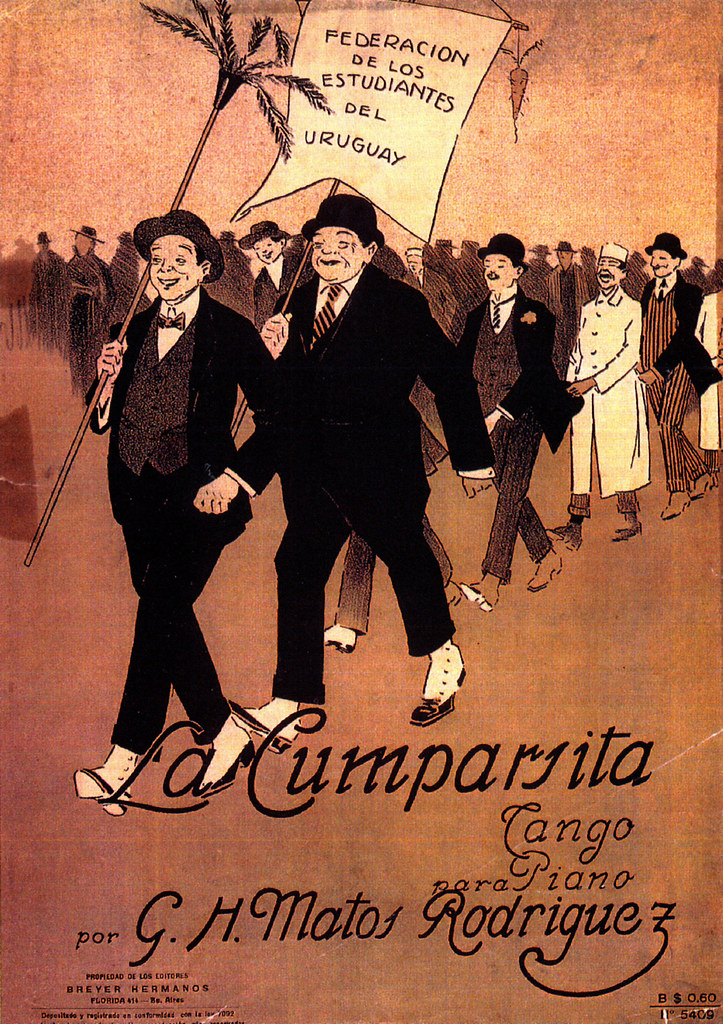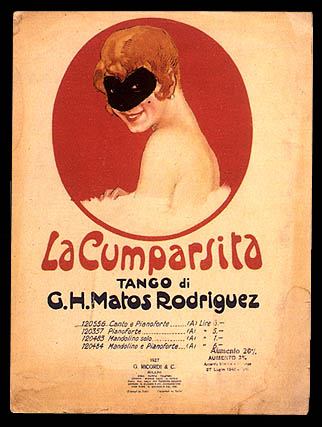
Note that April 16, 2017 is the 100th Anniversary of the song...
http://www.worldnewsenespanol.com/309_hispanic-world/4507519_uruguay-celebrates-100th-anniversary-of-la-cumparsita-tango.html
http://www.elintransigente.com/espectaculo/musica/2016/8/23/uruguay-quiere-declarar-2017-como-tango-la-cumparsita-398734.html
On the subject of why La Cumparsita is played as the last song at milongas:
This from Glen Royce on Facebook:
Alex: Ahhh- I thought the story was more well-known! :) Pugliese was a communist, and one night the police showed up at the milonga where his orquestra was playing, to bring him in, right when they were playing 'La Cumpa' ...my good tanguero friends down here in BA who are in their 70's and 80's say he WAS arrested, and so the milonga was finished- end of the night! (because the orquestra's director had been taken away...!) Anyway, feel free to read and visit the folllowing : ;)
"Once when Pugliese was playing La Cumparsita, the police entered the club he was performing in, and directed everything to stop as he was banned. The club owners said that they could not be interrupted whilst the orchestra was playing and the dancers was tangoing. On stage, Pugliese was told about this - so started playing La Cumparsita over and over again. The audience just kept on dancing! Eventually the police gave up and left. It was, perhaps, a world record in playing La Cumparsita?"
***Again, I have been told Pugliese DID get arrested and the milonga was finished for the night (no more director OR pianit...!) So that was the last song of the night! :)
And this from Luigi Seta - his blog at: http://tangopills.blogspot.com/2017/04/por-que-la-cumparsita-es-el-ultimo.html
Saturday, April 22, 2017
¿Por qué La Cumparsita es el último tango de la milonga? (Why is La Cumparsita the last tango of the milonga?)
Los milongueros asocian este tango inmortal con Juan D’Arienzo, El Rey del Compás, porque revolucionó todo el mercado con su grabación.
The milongueros associate this immortal tango with Juan D'Arienzo, El Rey del Compás, The King of the Beat, because he revolutionized the whole market with his recording.
Fue además el tema que más veces grabó, hasta en 7 oportunidades. En los años 1928 y 1929, con las voces de Carlos Dante y Raquel Notar, respectivamente, para el sello Electra, propiedad de su tío, Alfredo Améndola. Y luego para el sello Victor en otras cinco placas, en los años 1937, 1943, 1951, 1963 y 1971. La placa de 1951 tenía en la otra faz, la milonga de Pintín Castellanos La Puñalada, que también registró en cuatro ocasiones, y batió records de venta.
It was also the tango that he recorded the most times, up to 7 opportunities. In 1928 and 1929, with the voices of Carlos Dante and Raquel Notar, respectively, for the Electra label, owned by his uncle, Alfredo Améndola. And then for the Victor label on five other records, in 1937, 1943, 1951, 1963 and 1971. The record of 1951 had on the other side, the milonga of Pintín Castellanos La Puñalada, which also recorded four times, to became a sales blockbuster.
La versión de 1951 fue tan famosa, con más de un millón de discos vendidos sólo en Argentina, y más de doscientos mil en Japón, que el público deliraba al escucharla en sus presentaciones en vivo, entonces Juancito decide dejarla siempre para el final de sus shows, como la frutilla del postre.
The 1951 version was so famous, with more than one million albums sold only in Argentina, and more than two hundred thousand in Japan, that the audience raved when listening to it at their live performances, so Juancito decides to leave it always for the end of their Shows, as the icing on the cake.
Y fue así que se impuso como cierre de las milongas a partir de de los años cincuenta en todos los clubes de Buenos Aires. Y quedarse sin bailar este último tango significaba toda una frustración.
And so it was imposed as a closure of the milongas since the fifties in all clubs in Buenos Aires. And then, staying without dancing this last tango meant a whole frustration.
Los muchachos de entonces se reunían para escucharla y también se armaba toda una revolución en las milongas con este tema. Fulvio Salamanca, el pianista de D’Arienzo por 17 años, tuvo especial intervención en los arreglos de esta versión de 1951 y se nota su sabia mano en el resultado final. Una obra maestra y super milonguera.
The guys of the time met to listen to it at home, the streets, everywhere, and then a whole revolution was set up in the milongas with this tango. Fulvio Salamanca, the D'Arienzo pianist for 17 years, had an special intervention in the arrangements of this version of 1951 and it shows his wise hand in the final result. A super milonguera masterpiece.
A continuación La cumparsita por la orquesta de Juan D'Arienzo, en su versión del año 1951, quizás la más famosa de todas.
Next The cumparsita by the orchestra of Juan D'Arienzo, in its version of the year 1951, perhaps the most famous of all.
Presten atención al toque magistral del piano a cargo de Fulvio Salamanca, que le imprimió el clásico compás a la orquesta, una variación moderna y menos eléctrica, que la que le impusiera Rodolfo Biagi.
Pay attention to the masterful touch of the piano by Fulvio Salamanca, who impressed the classic compass to the orchestra, a modern and less electric variation, than that imposed by Rodolfo Biagi.
Escuchen a Enrique Alessio, primer bandoneón, en su famosa variación del segundo coro, magistral, sin palabras.
D'Arienzo, and his line of bandoneons
Junnissi, Lazzari and Alessio
Listen to Enrique Alessio, first bandoneon, in his famous variation of the second choir, masterful, without words.
No dejen de lado la melancolía del final, con el toque impecable del primer violín de la orquesta, Cayetano Puglisi.
Do not leave aside the melancholy of the end, with the impeccable touch of the first violin of the orchestra, Cayetano Puglisi.
Finalmente, la perfecta sincronización instrumental que en corto tiempo le diera a Juan D'Arienzo el acertado calificativo de El Rey del Compás.
Finally, the perfect instrumental synchronization that in a short time gave Juan D'Arienzo the correct qualifier of El Rey del Compás, the King of the Beat.
¡A disfrutar esta joya!
Enjoy this gem!
Here's my prior post:


La Cumparsita is the song that is traditionally the last song played at a milonga. It signals to everyone that this is the last song, and that the milonga has concluded. There was a time when I was on a mission to collect as many versions of the song as I could find. At this point, I have forty [40] distinct versions.
It was written by Gerardo Hernán Matos Rodríguez, an amateur pianist and architecture student, in late 1915 or early 1916 by all accounts. He was 17 years old when he wrote it. It's important to note that he was a student in Montevideo - so the song originated in Uruguay.
The song has a very interesting story behind it - with changed lyrics, new music arrangements, ownership and royalties lawsuits (four or five), and plenty of drama over the years. It's often billed as "the most famous tango in the world". Astor Piazzolla called it "the most frighteningly poor thing in this world" in reference to the original score by Matos Rodríguez and its simple melody.
Here are a couple of links to good, in depth treatments of the song and its history:
Keith Elshaw's www.totango.net
Ricardo García Blaya's www.todotango.com
Note that both of these sites contain a wealth of information about tango music and all things tango.
Alberto Paz' www.planet-tango.com includes a lyrics translation of the re-written version. Alberto's site is well known for his lyrics translations, and also includes a wealth of information about tango.
This 1930 version, with the original lyrics sung by the opera singer Tito Schipa, is my personal favorite.
Lastly, here's a "mashup" of many versions over 26 years...

No comments:
Post a Comment